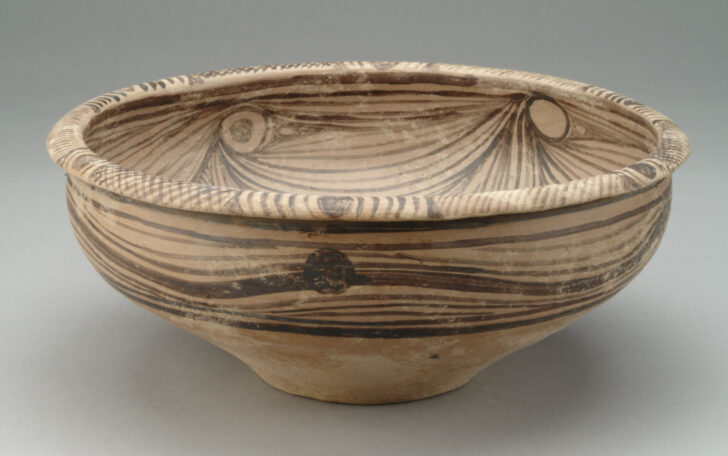Bowl
Chinese

Description
Subject Matter:
A large basin or bowl the Neolithic Majiayao phase (3100–2600 BCE) of Majiayao Culture from Majiayao, Gansu of the Yellow River Valley in northwestern China. Discovered by Johan Gunnar Andersson in 1921, by the 1980s approximately 60,000 items and 400 kilns had been discovered at Majiayao sites (He Li 1996, 22). The Majiayao phase of this neolithic culture shows more variation of shapes and decorations than the later Banshan or Machang phases. They were found in subterranean graves with conical bases placed into the local loess soil. Despite being placed in the ground, often the entire surfaces of Majiayao phase pots were decorated; however, the decoration on the exterior of this bowl only covers half of its surface, while the interior is completely covered. While it is impossible to know the meaning behind this decoration, researchers suggest perhaps the swirling and wavy lines represent the cosmos, swirling water or eddies of the nearby Yellow River, which was a major source of food.
These bowls are extraordinarily thin and lightweight. Constructed by using the coiling method, they were then paddled and scraped thin, covered in a fine slip, and then painted with mineral pigments before being fired in small, simple updraft kilns. The mineral pigments consisted of iron and manganese oxides to give red, brown and black hues.
Physical Description:
A wide round bowl with an articulated, everted wide rim and a conical lower body on a flat base. It is decorated with wavy linear patterns and black solid dots on the upper half of the exterior, swirling lines with dots on the interior, and cross-hatching on the rim.
Usage Rights:
If you are interested in using an image for a publication, please visit https://umma.umich.edu/request-image/ for more information and to fill out the online Image Rights and Reproductions Request Form.